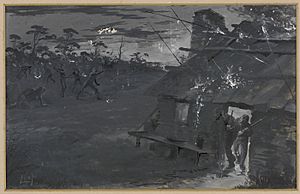Australian frontier wars facts for kids
Quick facts for kids Australian frontier wars |
|||||||
|---|---|---|---|---|---|---|---|
 New South Wales Mounted Police engaging Aboriginal warriors during the Waterloo Creek massacre of 1838 |
|||||||
|
|||||||
| Belligerents | |||||||
Northern Territory |
Aboriginal Australians: Eora, Dharug, Gandangara and Tharawal Wiradjuri Wonnarua and Gamilaroi Gunditjmara Palawa peoples Noongar peoples Jagera Many others |
||||||
| Commanders and leaders | |||||||
Others |
Pemulwuy Musquito Windradyne Yagan Tunnerminnerwait Truganini Tarenorerer Multuggerah Jandamarra Dundalli Mannalargenna Nemarluk Tarrarer Cocknose Partpoaermin Koort Kirrup Alkapurata |
||||||
| Strength | |||||||
|
|
||||||
| Casualties and losses | |||||||
| Minimum 2,000–2,500 dead | 100,000-115,000 dead | ||||||
The Australian frontier wars were a series of violent conflicts. They happened between Indigenous Australians (including both Aboriginal Australians and Torres Strait Islanders) and non-Indigenous settlers. These conflicts took place during the colonisation of Australia. The first fights started a few months after the First Fleet arrived in January 1788. The last conflicts happened in the early 1900s, with some as late as 1934.
It's estimated that at least 100,000 Indigenous Australians died. Between 2,000 and 2,500 settlers also died. These conflicts happened in many different places across Australia.
Contents
- Australia's Early History and Population
- Traditional Aboriginal Ways of Fighting
- General History of the Conflicts
- Conflicts in New South Wales
- Conflicts in Tasmania
- Conflicts in Western Australia
- Conflicts in South Australia
- Conflicts in Victoria
- Conflicts in Queensland
- Conflicts in the Northern Territory
- How History is Written
- See Also
Australia's Early History and Population
In 1770, a British expedition led by Lieutenant James Cook sailed along Australia's east coast. On April 29, Cook's group tried to land at Botany Bay. Local Dharawal people tried to stop them. Cook ordered shots to be fired, injuring one man. The Dharawal men then threw a spear, but it didn't hurt anyone. Cook ordered more shots, and the men ran away. Cook did not make further contact with the Dharawal Nation.
Cook claimed the land for Britain on August 22, 1770, on Possession Island. He believed the land was terra nullius, meaning "land belonging to nobody." This idea was later overturned by the High Court of Australia.
In 1786, the British government decided to create a prison colony in Australia. The first Governor, Captain Arthur Phillip, was told to be friendly with Indigenous Australians. He tried to avoid conflict.
British colonisation began in January 1788 in what is now New South Wales. It then spread to Tasmania and Victoria from 1803. Conflicts with Aboriginal people were most intense in Queensland. This was because Queensland had the largest Indigenous population before European arrival.
The table below shows how the Indigenous population was spread across Australia in 1788.
| State/territory | Population in numbers | Population in percentage |
|---|---|---|
| Queensland | 300,000 | 37.9% |
| Western Australia | 150,000 | 20.2% |
| New South Wales | 160,000 | 18.9% |
| Northern Territory | 100,000 | 12.6% |
| Victoria | 45,000 | 5.7% |
| South Australia | 32,000 | 4.0% |
| Tasmania | 5,000 | 0.6% |
| Estimated total | 795,000 | 100% |
How Diseases Affected Indigenous People
Diseases brought by Europeans had a huge impact on Indigenous Australians. Illnesses like smallpox, common cold, flu, measles, and tuberculosis spread quickly. These diseases caused many deaths, sometimes reducing populations by 50% or more. This happened even before settlers moved further inland. The diseases weakened Indigenous communities. This made it harder for them to resist the invasion and loss of their lands.
Traditional Aboriginal Ways of Fighting
Traditional Aboriginal fighting was different from European warfare. Aboriginal people didn't have separate ideas of "war" and "peace." Fighting often happened between groups to settle disagreements. The goal was usually to show one group's strength, not to conquer land. This was because their culture was deeply connected to specific territories.
In 1840, an expert named Horatio Hale described four types of traditional Aboriginal fighting:
- Formal battles: Two groups of warriors fought. These battles usually stopped after a few people were hurt or killed. This was to make sure both groups could survive.
- Ritual trials: These were punishments for crimes like murder. Weapons were used to cause injury, and the person who committed the crime was expected to accept it.
- Raids for women: These raids were about taking women from other groups. Women were important for gathering food and having children, which helped groups survive.
- Revenge attacks: One group attacked another to punish them for a member's actions, like a murder. Sometimes, these attacks involved sneaking into a camp at night.
Aboriginal warfare was both limited and widespread. It was limited because groups were small, and there wasn't one leader for many groups. Fights also had to be short because people needed to hunt for food. However, it was widespread because everyone in the community took part. Boys learned to fight from a young age. Every initiated male became a warrior. Women sometimes fought or encouraged fighters.
Aboriginal warriors used different weapons. Spears, clubs, and shields were common for close fighting. Spears (often with spear throwers), boomerangs, and stones were thrown from a distance. Tactics included surprise attacks and ambushes, especially at night. To counter this, groups often moved campsites or put out campfires quickly.
General History of the Conflicts
First European Arrivals
When the First Fleet arrived in Sydney in January 1788, relations were initially peaceful. But tensions grew as the British cleared land and fished. In May 1788, five convicts were killed, and an Indigenous man was wounded. The British became worried when large groups of Indigenous people were seen near the colony. Despite this, Governor Phillip tried to avoid conflict. He even forbade revenge after being speared in 1790. However, he did send out two groups to punish Indigenous people after his huntsman was killed by a warrior named Pemulwuy in December 1790. Neither attempt was successful.
Spreading Across the Land
During the late 1700s and early 1800s, the British settled more areas along the Australian coast. At first, these settlements were small, and there wasn't much conflict. But as settlements grew, they took over Indigenous lands and disrupted traditional food sources. This led to fighting that continued for the next 150 years. Indigenous people reacted with hostility when their resources were threatened. European diseases also greatly reduced Indigenous populations.
The conflicts were usually between groups of settlers and individual Indigenous groups. It wasn't always an organised war. Sometimes, British soldiers and police were involved. Not all Indigenous Australians fought against the Europeans. Some even joined police units and helped in attacks on other tribes. Settlers often responded with violence, leading to many massacres. Activities like pastoral squatting (taking land for livestock) and gold rushes caused major conflicts.
Unequal Weapons
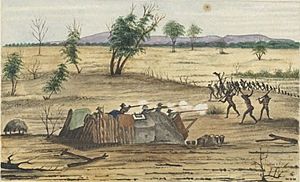
There's debate about whether the conflict was one-sided. While many more Indigenous Australians died, Europeans had better technology. Indigenous tactics used spears, clubs, and other simple weapons. Unlike the Māori in New Zealand or Native Americans in North America, most Indigenous Australians didn't widely adopt firearms. This meant they were never a serious military threat, even if settlers feared them.
Sometimes, large groups of Indigenous people attacked Europeans in open areas. They tried to use their numbers to surround opponents. They would wait for the first shots, then throw spears while settlers reloaded. But open warfare usually resulted in more losses for Indigenous Australians.
Firearms were key to European success. Early guns were slow and not very accurate. This sometimes gave Aboriginal people a chance to get close. But by 1850, guns improved greatly. Revolvers and faster rifles became available. These weapons, combined with horses, gave Europeans a big advantage in open areas. Europeans also changed their tactics. They used surprise night attacks and tried to trap Aboriginal people against cliffs or rivers.
Localised Conflicts
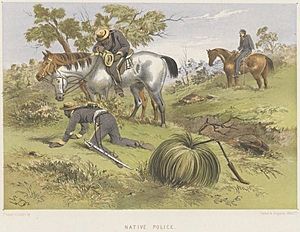
Fighting was localised because Indigenous groups didn't form large alliances. The conflict was a series of violent clashes and massacres across Australia. Historian Geoffrey Blainey noted that disease was the main cause of death for Aboriginal people. Smallpox, measles, and influenza spread quickly, causing many deaths and weakening communities.
One of the last violent incidents on the "frontier" was the Caledon Bay crisis in 1932–34. It started when Indigenous people speared Japanese poachers who had attacked Yolngu women. Then, a policeman was killed. Public opinion turned to support the Aboriginal people involved. This led to the first appeal to the High Court of Australia on behalf of an Indigenous Australian. After this, anthropologist Donald Thomson lived among the Yolngu people. Around this time, activists like Sir Douglas Nicholls began fighting for Aboriginal rights within the Australian political system. This marked the end of the frontier conflict era.
Friendly Relations Were Also Common
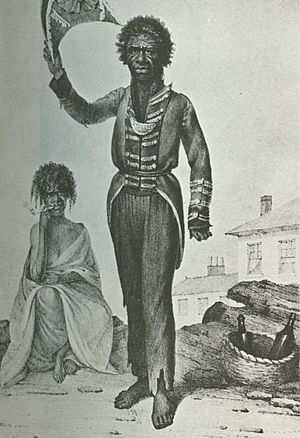
Not all encounters were negative. Early European explorers often wrote positively about Aboriginal customs. They relied on Aboriginal guides and help. For example, Charles Sturt used Aboriginal envoys to explore the Murray-Darling River. The only survivor of the Burke and Wills expedition was cared for by local Aboriginal people. The famous Aboriginal explorer Jackey Jackey bravely stayed with his ill friend Edmund Kennedy in Cape York.
Respectful studies were also done, like The Native Tribes of Central Australia (1899) by Walter Baldwin Spencer and Frank Gillen. Donald Thomson also studied the people of Arnhem Land. In inland Australia, Aboriginal stockmen were highly valued for their skills with animals.
Conflicts in New South Wales
Hawkesbury and Nepean Wars
The first frontier war began in 1795. British settlers started farms along the Hawkesbury River west of Sydney. Local Dharug people raided these farms. In 1816, Governor Lachlan Macquarie sent soldiers. They patrolled the Hawkesbury Valley and ended the conflict by killing 14 Indigenous Australians in an ambush.
Indigenous Australians led by Pemulwuy also raided areas around Parramatta between 1795 and 1802. These attacks led Governor Philip Gidley King to allow settlers to shoot Indigenous Australians on sight in certain areas in 1801.
Bathurst War
Conflict flared again when the British moved into inland New South Wales. Settlers crossing the Blue Mountains were attacked by Wiradjuri warriors. These warriors killed livestock and stock-keepers. Settlers responded with violence.
In response, Governor Thomas Brisbane declared martial law on August 14, 1824. This was to stop the killing of "Black Women and Children, and unoffending White Men." Martial law ended in December 1824. Governor Brisbane praised the troops for restoring peace without more bloodshed. He also created the New South Wales Mounted Police. They were first used against bushrangers in Bathurst in 1825. Later, they were sent to the Hunter Region in 1826 after fighting broke out there.
Wars on the Plains
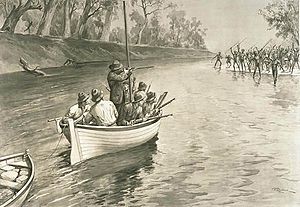
From the 1830s, British settlement quickly spread through eastern Australia. This led to widespread conflict. In the Liverpool Plains, 16 British and up to 500 Indigenous Australians were killed between 1832 and 1838. This violence included massacres of Indigenous people, like the Waterloo Creek massacre and Myall Creek massacre in 1838. The fighting in this region lasted until 1843. More violence happened in the New England region in the early 1840s.
Conflicts in Tasmania
The British settled Van Diemen's Land (now Tasmania) in 1803. Relations with local Indigenous people were mostly peaceful until the mid-1820s. Then, the expansion of farms caused conflict over land. This led to a long period of fighting known as the "Black War". In some areas, farmers had to fortify their homes. More than 50 British were killed between 1828 and 1830. This was considered the "most successful Aboriginal resistance in Australia's history."
In 1830, Lieutenant-Governor George Arthur tried to end the "Black War." He launched a huge operation called the "Black Line". Ten percent of the colony's male civilians, along with police and soldiers, marched across settled areas. They tried to remove Indigenous Australians from the region. Few Indigenous people were captured. However, the operation discouraged Indigenous raiding parties. Gradually, they agreed to leave their land for a reservation on Flinders Island.
Conflicts in Western Australia
The first British settlement in Western Australia was at Albany in 1826. Relations with the local Mineng people were generally good. However, open conflict broke out in Western Australia in the 1830s. This happened as the Swan River Colony expanded from Perth.
The Pinjarra massacre is the most famous event. It happened on October 28, 1833. A group of British settlers led by Governor Stirling attacked an Indigenous camp on the Murray River.
The Noongar Nation was forced from their traditional hunting grounds. They also lost access to sacred sites. To survive, they started taking settlers' crops and killing livestock. In 1831, a Noongar person was murdered for taking potatoes. In response, Yagan killed a servant, which was allowed under Noongar law. Yagan was arrested and sentenced to death. But a settler argued that Yagan was defending his land. Yagan was treated as a prisoner of war and exiled to Carnac Island, but he later escaped.
Fighting continued into the 1840s along the Avon River near York.
In the Busselton area, relations between settlers and the Wardandi people became very tense. This led to violence and several Aboriginal deaths. In 1841, George Layman was killed by Wardandi Elder Gaywal. This happened after Layman reportedly insulted Gaywal or refused to let Gaywal's wives return to him. A search for Layman's killer led to more bloodshed. Captain John Molloy and others killed many Aboriginal people in what is known as the Wonnerup massacre. They eventually killed Gaywal and imprisoned his three sons on Rottnest Island.
The discovery of gold near Coolgardie in 1892 brought many prospectors. This caused more fighting on Wangkatha land.
Conflict continued in northern Western Australia until the 1920s. A Royal Commission in 1926 found that at least eleven Indigenous Australians were murdered in the Forrest River massacre. This was in revenge for the death of a European.
Conflicts in South Australia
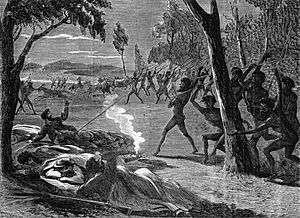
South Australia was settled in 1836 without convicts. The plan was for settlers to buy land before arriving. This was meant to create a balanced colony. The government was aware of the conflicts in other colonies. On Proclamation Day in 1836, Governor Hindmarsh stated that Indigenous people should have the same protection under the law as other British subjects.
Governor Gawler declared in 1840 that Aboriginal people had "absolute right or proprietary and hereditary possession" of their land. He ordered land to be set aside for them. But settlers strongly opposed this, wanting the best land for themselves. Eventually, land was only available to Aboriginal people if it helped them become Christian farmers.
Calling Aboriginal people British citizens gave them rights and duties they didn't understand. It also ignored their existing customary law. Aboriginal people couldn't testify in court because they weren't Christians and couldn't swear on a bible. There were also big problems with translation. The good intentions of the colony's leaders soon clashed with the fears of both Aboriginal people and new settlers. The failure to properly deal with Aboriginal land rights was a main cause of the violence that followed.
Soon after the colony began, many sheep and cattle were brought overland. There were many conflicts between Aboriginal people and drovers. Aboriginal people wanted to protect their Country, while drovers quickly shot to protect themselves and their animals.
In 1840, the ship Maria was wrecked. A search party found that all 26 survivors had been killed. The Governor declared martial law. A police group was sent to punish the local Indigenous people. They arrested some Aboriginal people. Two men were found guilty and executed by a special tribunal. This caused a big debate in the colony about justice outside the normal law.
The town of Port Lincoln also saw early conflict. A small number of shepherds began taking land from a large Aboriginal population. Deaths happened on both sides. Police and soldiers were sent to the Eyre Peninsula, but they were often ineffective. By the mid-1840s, the deadlier European weapons had a big effect. Several alleged Aboriginal leaders were tried and executed in Adelaide.
Similar conflicts happened in the South East and north of the state as settlers moved onto Aboriginal land. The government tried to follow its original promises, but the conflict was unavoidable due to the dispossession of land.
Conflicts in Victoria
Fighting also happened in early Victoria after it was settled in 1834.
In 1833–34, a battle over a beached whale between whalers and Gunditjmara people led to the Convincing Ground massacre near Portland, Victoria.
The Mount Cottrell massacre in 1836 was revenge for the killing of a settler named Charles Franks. He had taken land west of Melbourne.
A clash at Benalla in 1838, known as the Battle of Broken River, killed at least seven white settlers. This marked the start of 15 years of conflict in the colony.
In 1839, a revenge raid against Aboriginal resistance in central Victoria resulted in the Campaspe Plains massacre.
Indigenous groups in Victoria focused on "economic warfare." They killed tens of thousands of sheep. Many British settlers arrived in Victoria during the 1840s. They quickly outnumbered the Indigenous population.
From 1840, the Eumerella Wars took place in southwest Victoria. Many years of violence occurred during the Warrigal Creek and Gippsland massacres.
In 1842, settlers from the Port Fairy area wrote to Charles La Trobe. They asked for better protection from "outrages committed by natives." They listed many incidents of conflict and economic warfare.
In the late 1840s, frontier conflict continued in the Wimmera.
Conflicts in Queensland
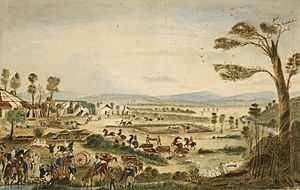
The frontier wars were especially violent in Queensland. This was because Queensland had a very large Indigenous population. Studies suggest that Queensland accounted for over one-third of Australia's Indigenous population before European contact.
Queensland saw the most bloodshed during colonisation in Australia. Records show the most shootings and massacres of Indigenous people here. It also had the deadliest attacks on white settlers. The Queensland Native Police Force alone is estimated to have caused at least 24,000 Indigenous deaths. Recent studies suggest that total deaths in Queensland's frontier wars were around 66,680. This includes about 65,180 Aboriginal deaths and an estimated 1,500 white settler deaths.
European settlement in what is now Queensland began in 1824. Free settlement started in 1838. It quickly expanded into areas like the Darling Downs and Brisbane Valley. This often led to widespread fighting and many deaths. The conflict then spread north to the Wide Bay and Burnett River regions. At one point, the settlement of Maryborough was almost under siege.
Both sides committed terrible acts. Settlers poisoned many Indigenous people, for example, at Kilcoy in 1842 and Whiteside in 1847. Indigenous warriors killed 19 settlers during the Cullin-La-Ringo massacre on October 17, 1861. At the Battle of One Tree Hill in September 1843, Multuggerah and his warriors ambushed settlers. This was in revenge for the Kilcoy poisoning.
Queensland's Native Police Force was formed in 1848.
Major Massacres in Queensland
Some of the largest documented massacres in southeast Queensland were the Kilcoy and Whiteside poisonings. Each was said to have killed up to 70 Aboriginal people using poisoned flour. Central Queensland was hit hard in the 1860s and 1870s. Writers mentioned the Skull Hole, Bladensburg, or Mistake Creek massacre near Winton. In 1901, it was said to have killed up to 200 Aboriginal people.
In 1869, a newspaper reported that "120 aboriginals disappeared on two occasions forever." Frontier violence was highest on the northern mining frontier in the 1870s. This was especially true in the Cook district and on the Palmer and Hodgkinson River goldfields. Many Aboriginal lives were lost in well-known massacres. The Cape Bedford massacre on February 20, 1879, reportedly killed 28 people. This was revenge for two white "cedar-getters" being injured.
Raids by the Kalkatungu people kept settlers out of Western Queensland for ten years. In September 1884, they attacked settlers and native police at Battle Mountain near Cloncurry. The battle ended badly for the Kalkadoon, who suffered heavy losses. Fighting continued in North Queensland. Indigenous raiders attacked sheep and cattle, while native police carried out punitive expeditions.
The conflict in Queensland was the bloodiest in Australia's colonial history. Some studies suggest about 1,500 non-Indigenous people were killed. Others suggest over 65,000 Aboriginal people were killed. Parts of Central and North Queensland saw particularly heavy fighting. Some sources describe these events as genocide.
Conflicts in the Northern Territory
The British tried three times to set up military outposts in northern Australia. The first settlement at Fort Dundas on Melville Island was built in 1824. It was abandoned in 1829 due to attacks from the local Tiwi people. Some fighting also happened near Fort Wellington from 1827 to 1829. The third settlement, Fort Victoria, was built in 1838 and abandoned in 1849.
The final battles of the frontier wars happened in the Northern Territory. A permanent settlement was established at modern-day Darwin in 1869. As farmers tried to take Indigenous land, conflict began. This fighting continued into the 1900s. It was driven by revenge for European deaths and the desire of farmers to secure the land they had taken. At least 31 Indigenous men were killed by police in the Coniston massacre in 1928. More revenge expeditions happened in 1932 and 1933.
How History is Written

For a long time, historians didn't pay much attention to armed Indigenous resistance. It wasn't seen as a "war." In 1968, anthropologist W. E. H. Stanner called this the "great Australian silence." He meant that Indigenous Australians were left out of Australian history.
Books about the conflicts started appearing in the 1970s and 1980s. The first history of the Australian frontier from an Indigenous viewpoint was Henry Reynolds' The Other Side of the Frontier, published in 1982.
Between 2000 and 2002, Keith Windschuttle argued that there hadn't been long frontier wars. He claimed historians had made up evidence. This led to the "history wars," where historians debated how much conflict there really was.
The Australian frontier wars are not officially remembered at the Australian War Memorial in Canberra. The Memorial says it's outside their purpose because it didn't involve Australian military forces. Many historians disagree. They argue that the fighting should be remembered because it involved many Indigenous Australians and paramilitary units. In September 2022, the Memorial's chair announced they would work towards a "much broader, a much deeper depiction and presentation of the violence committed against Indigenous people." This was seen as a major step forward in how Australia understands its history.
See Also
 In Spanish: Guerras de frontera de Australia para niños
In Spanish: Guerras de frontera de Australia para niños
- List of massacres of Indigenous Australians
- List of conflicts in Australia
- Musquito a warrior of the Gai-Mariagal Nation
- Tarenorerer, also known as Walyer, Waloa or Walloa was a rebel leader of the Indigenous Australians in Tasmania
- Tunnerminnerwait was an Australian Aboriginal resistance fighter and from the Parperloihener Nation in Tasmania
- Windradyne warrior and resistance leader of the Wiradjuri Nation
- American Indian Wars, comparable events in US and Canadian history
- Arauco War and Conquest of the Desert, comparable events in Chile and Argentina
- Historical Records of Australia
- The Great Trek, Xhosa Wars, and Anglo-Zulu war; comparable events in South Africa
- Russian conquest of the Caucasus; comparable events in Russia


